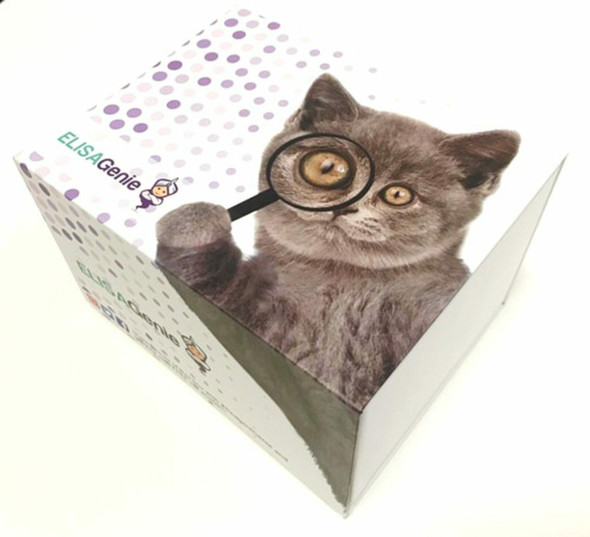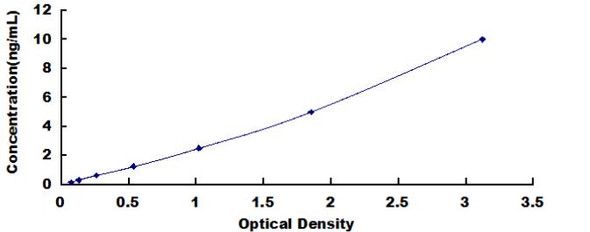Human Epigenetics and Nuclear Signaling ELISA Kits
Human PXR (Pregnane X Receptor) CLIA Kit (HUES01264)
- SKU:
- HUES01264
- Product Type:
- ELISA Kit
- ELISA Type:
- CLIA Kit
- Size:
- 96 Assays
- Sensitivity:
- 18.75pg/mL
- Range:
- 31.25-2000pg/mL
- ELISA Type:
- Sandwich
- Reactivity:
- Human
- Sample Type:
- Serum, plasma and other biological fluids
- Research Area:
- Epigenetics and Nuclear Signaling
Description
| Assay type: | Sandwich |
| Format: | 96T |
| Assay time: | 4.5h |
| Reactivity: | Human |
| Detection method: | Chemiluminescence |
| Detection range: | 31.25-2000 pg/mL |
| Sensitivity: | 18.75 pg/mL |
| Sample volume: | 100µL |
| Sample type: | Serum, plasma and other biological fluids |
| Repeatability: | CV < 15% |
| Specificity: | This kit recognizes Human PXR in samples. No significant cross-reactivity or interference between Human PXR and analogues was observed. |
This kit uses Sandwich-CLIA as the method. The micro CLIA plate provided in this kit has been pre-coated with an antibody specific to Human PXR. Standards or samples are added to the appropriate micro CLIA plate wells and combined with the specific antibody. Then a biotinylated detection antibody specific for Human PXR and Avidin-Horseradish Peroxidase (HRP) conjugate are added to each micro plate well successively and incubated. Free components are washed away. The substrate solution is added to each well. Only those wells that contain Human PXR, biotinylated detection antibody and Avidin-HRP conjugate will appear fluorescence. The Relative light unit (RLU) value is measured spectrophotometrically by the Chemiluminescence immunoassay analyzer. The RLU value is positively associated with the concentration of Human PXR. The concentration of Human PXR in the samples can be calculated by comparing the RLU of the samples to the standard curve.
| UniProt Protein Function: | Nuclear receptor that binds and is activated by variety of endogenous and xenobiotic compounds. Transcription factor that activates the transcription of multiple genes involved in the metabolism and secretion of potentially harmful xenobiotics, drugs and endogenous compounds. Activated by the antibiotic rifampicin and various plant metabolites, such as hyperforin, guggulipid, colupulone, and isoflavones. Response to specific ligands is species-specific. Activated by naturally occurring steroids, such as pregnenolone and progesterone. Binds to a response element in the promoters of the CYP3A4 and ABCB1/MDR1 genes. |
| NCBI Summary: | This gene product belongs to the nuclear receptor superfamily, members of which are transcription factors characterized by a ligand-binding domain and a DNA-binding domain. The encoded protein is a transcriptional regulator of the cytochrome P450 gene CYP3A4, binding to the response element of the CYP3A4 promoter as a heterodimer with the 9-cis retinoic acid receptor RXR. It is activated by a range of compounds that induce CYP3A4, including dexamethasone and rifampicin. Several alternatively spliced transcripts encoding different isoforms, some of which use non-AUG (CUG) translation initiation codon, have been described for this gene. Additional transcript variants exist, however, they have not been fully characterized. [provided by RefSeq, Jul 2008] |
| UniProt Code: | O75469 |
| NCBI GenInfo Identifier: | 6093860 |
| NCBI Gene ID: | 8856 |
| NCBI Accession: | O75469. 1 |
| UniProt Secondary Accession: | O75469,Q006P5, Q008C8, Q96AC7, Q9UJ22, Q9UJ23, Q9UJ24 Q9UJ25, Q9UJ26, Q9UJ27, Q9UNW4, |
| UniProt Related Accession: | O75469 |
| Molecular Weight: | 53,899 Da |
| NCBI Full Name: | Nuclear receptor subfamily 1 group I member 2 |
| NCBI Synonym Full Names: | nuclear receptor subfamily 1 group I member 2 |
| NCBI Official Symbol: | NR1I2 |
| NCBI Official Synonym Symbols: | BXR; PAR; PRR; PXR; SAR; SXR; ONR1; PAR1; PAR2; PARq |
| NCBI Protein Information: | nuclear receptor subfamily 1 group I member 2 |
| UniProt Protein Name: | Nuclear receptor subfamily 1 group I member 2 |
| UniProt Synonym Protein Names: | Orphan nuclear receptor PAR1; Orphan nuclear receptor PXR; Pregnane X receptor; Steroid and xenobiotic receptor; SXR |
| Protein Family: | Nuclear receptor subfamily |
| UniProt Gene Name: | NR1I2 |
| UniProt Entry Name: | NR1I2_HUMAN |
As the RLU values of the standard curve may vary according to the conditions of the actual assay performance (e. g. operator, pipetting technique, washing technique or temperature effects), the operator should establish a standard curve for each test. Typical standard curve and data is provided below for reference only.
| Concentration (pg/mL) | RLU | Average | Corrected |
| 2000 | 53674 57768 | 55721 | 55693 |
| 1000 | 23430 24518 | 23974 | 23946 |
| 500 | 11616 10448 | 11032 | 11004 |
| 250 | 5076 5512 | 5294 | 5266 |
| 125 | 2795 2421 | 2608 | 2580 |
| 62.5 | 1347 1275 | 1311 | 1283 |
| 31.25 | 653 695 | 674 | 646 |
| 0 | 27 29 | 28 | -- |
Precision
Intra-assay Precision (Precision within an assay): 3 samples with low, mid range and high level Human PXR were tested 20 times on one plate, respectively.
Inter-assay Precision (Precision between assays): 3 samples with low, mid range and high level Human PXR were tested on 3 different plates, 20 replicates in each plate.
| Intra-assay Precision | Inter-assay Precision | |||||
| Sample | 1 | 2 | 3 | 1 | 2 | 3 |
| n | 20 | 20 | 20 | 20 | 20 | 20 |
| Mean (pg/mL) | 104.20 | 206.55 | 908.49 | 111.55 | 203.46 | 981.23 |
| Standard deviation | 9.47 | 22.22 | 63.59 | 11.67 | 14.38 | 110.29 |
| C V (%) | 9.09 | 10.76 | 7.00 | 10.46 | 7.07 | 11.24 |
Recovery
The recovery of Human PXR spiked at three different levels in samples throughout the range of the assay was evaluated in various matrices.
| Sample Type | Range (%) | Average Recovery (%) |
| Serum (n=5) | 90-106 | 98 |
| EDTA plasma (n=5) | 95-111 | 101 |
| Cell culture media (n=5) | 92-104 | 98 |
Linearity
Samples were spiked with high concentrations of Human PXR and diluted with Reference Standard & Sample Diluent to produce samples with values within the range of the assay.
| Serum (n=5) | EDTA plasma (n=5) | Cell culture media (n=5) | ||
| 1:2 | Range (%) | 93-109 | 98-115 | 102-120 |
| Average (%) | 101 | 105 | 109 | |
| 1:4 | Range (%) | 99-115 | 89-103 | 85-97 |
| Average (%) | 105 | 95 | 91 | |
| 1:8 | Range (%) | 86-102 | 90-106 | 94-109 |
| Average (%) | 93 | 97 | 102 | |
| 1:16 | Range (%) | 93-107 | 86-100 | 85-98 |
| Average (%) | 98 | 93 | 92 |
An unopened kit can be stored at 4°C for 1 month. If the kit is not used within 1 month, store the items separately according to the following conditions once the kit is received.
| Item | Specifications | Storage |
| Micro CLIA Plate(Dismountable) | 8 wells ×12 strips | -20°C, 6 months |
| Reference Standard | 2 vials | |
| Concentrated Biotinylated Detection Ab (100×) | 1 vial, 120 µL | |
| Concentrated HRP Conjugate (100×) | 1 vial, 120 µL | -20°C(shading light), 6 months |
| Reference Standard & Sample Diluent | 1 vial, 20 mL | 4°C, 6 months |
| Biotinylated Detection Ab Diluent | 1 vial, 14 mL | |
| HRP Conjugate Diluent | 1 vial, 14 mL | |
| Concentrated Wash Buffer (25×) | 1 vial, 30 mL | |
| Substrate Reagent A | 1 vial, 5 mL | 4°C (shading light) |
| Substrate Reagent B | 1 vial, 5 mL | 4°C (shading light) |
| Plate Sealer | 5 pieces | |
| Product Description | 1 copy | |
| Certificate of Analysis | 1 copy |
- Set standard, test sample and control (zero) wells on the pre-coated plate and record theirpositions. It is recommended to measure each standard and sample in duplicate. Note: addall solutions to the bottom of the plate wells while avoiding contact with the well walls. Ensuresolutions do not foam when adding to the wells.
- Aliquot 100 µL of standard solutions into the standard wells.
- Add 100 µL of Sample / Standard dilution buffer into the control (zero) well.
- Add 100 µL of properly diluted sample (serum, plasma, tissue homogenates and otherbiological fluids. ) into test sample wells.
- Cover the plate with the sealer provided in the kit and incubate for 90 min at 37 °C.
- Aspirate the liquid from each well, do not wash. Immediately add 100 µL of BiotinylatedDetection Ab working solution to each well. Cover the plate with a plate seal and gently mix. Incubate for 1 hour at 37 °C.
- Aspirate or decant the solution from the plate and add 350 µL of wash buffer to each welland incubate for 1-2 minutes at room temperature. Aspirate the solution from each well andclap the plate on absorbent filter paper to dry. Repeat this process 3 times. Note: a microplatewasher can be used in this step and other wash steps.
- Add 100 µL of HRP Conjugate working solution to each well. Cover with a plate seal andincubate for 30 min at 37 °C.
- Aspirate or decant the solution from each well. Repeat the wash process for five times asconducted in step 7.
- Add 100 µL of Substrate mixture solution to each well. Cover with a new plate seal andincubate for no more than 5 min at 37 °C. Protect the plate from light.
- Determine the RLU value of each well immediately.






